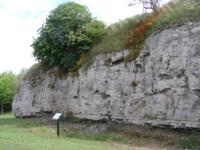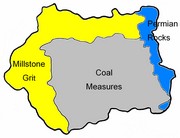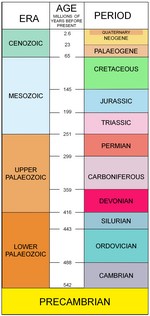 |
West Yorkshire Geology |
 |
|
|
MILLSTONE GRITThis term is used for a series of sandstones, siltstones and shales (mudstones) which date from the Namurian epoch of the Upper Carboniferous period and are about 320 million years old. The area that is now northern England lay in a subsiding basin between high mountain ranges. Rivers carried sediments which compressed under pressure of overlying rocks to give a rock sequence which is about 1700m thick. Deltas of sand built out over deeper waters in which clay and mud was deposited. Sea-level fluctuated because of global temperature changes, so alternating beds of mudstones and sandstones are found. River and delta sediments contain plant fossils, whereas mudstones contain marine fossils, particularly molluscs such as goniatites (like the WYGT logo) and shells.COAL MEASURESAfter the Millstone Grit rocks were deposited the seas became shallower and deltas built out from the coastlines. Sands and muds brought down by rivers were deposited in huge channels, much like the present Amazon Basin. The continent was close to the equator, so the land surface was covered with luxuriant vegetation, such as tree ferns and other spore-bearing plants. In stagnant lakes and marshes, plant material decomposed without oxygen, so that carbon was retained in the muds. Carbon was locked into coal seams during later burial by sediments. Tree branch and root fossils are very common in river sandstones, whereas marine shell fossils are found in mudstones which were deposited in shallow seas, as sea-levels continued to fluctuate. |
|
PERMIAN ROCKSThe Permian period followed the Carboniferous period about 290 million years ago. Plate tectonic uplift of southern Europe formed large mountains, so that northern England lay above sea-level in a hot, arid climate. Wind erosion produced blown sand so the first Permian rocks are dune-bedded desert sands called the Yellow Sands Formation, found in a few places in the east of the county. In Late Permian times the land was flooded by a shallow, salty sea called the Zechstein Sea, which dried out regularly because of high evaporation and sea-level fluctuations, leaving precipitated carbonates and other salts behind. The carbonates have been altered to yellow dolomitic limestones during later burial, interbedded with reddish mudstones. Fossils are rare, because not many forms of life could survive in such saline waters.FURTHER READINGRocks and Landscapes of Huddersfield,available from Huddersfield Geology Group http:/www.huddersfieldgeology.org.uk
|
© Copyright West Yorkshire Geology Trust 2011-2018. All rights reserved.
Web Page by Barry Tymon
